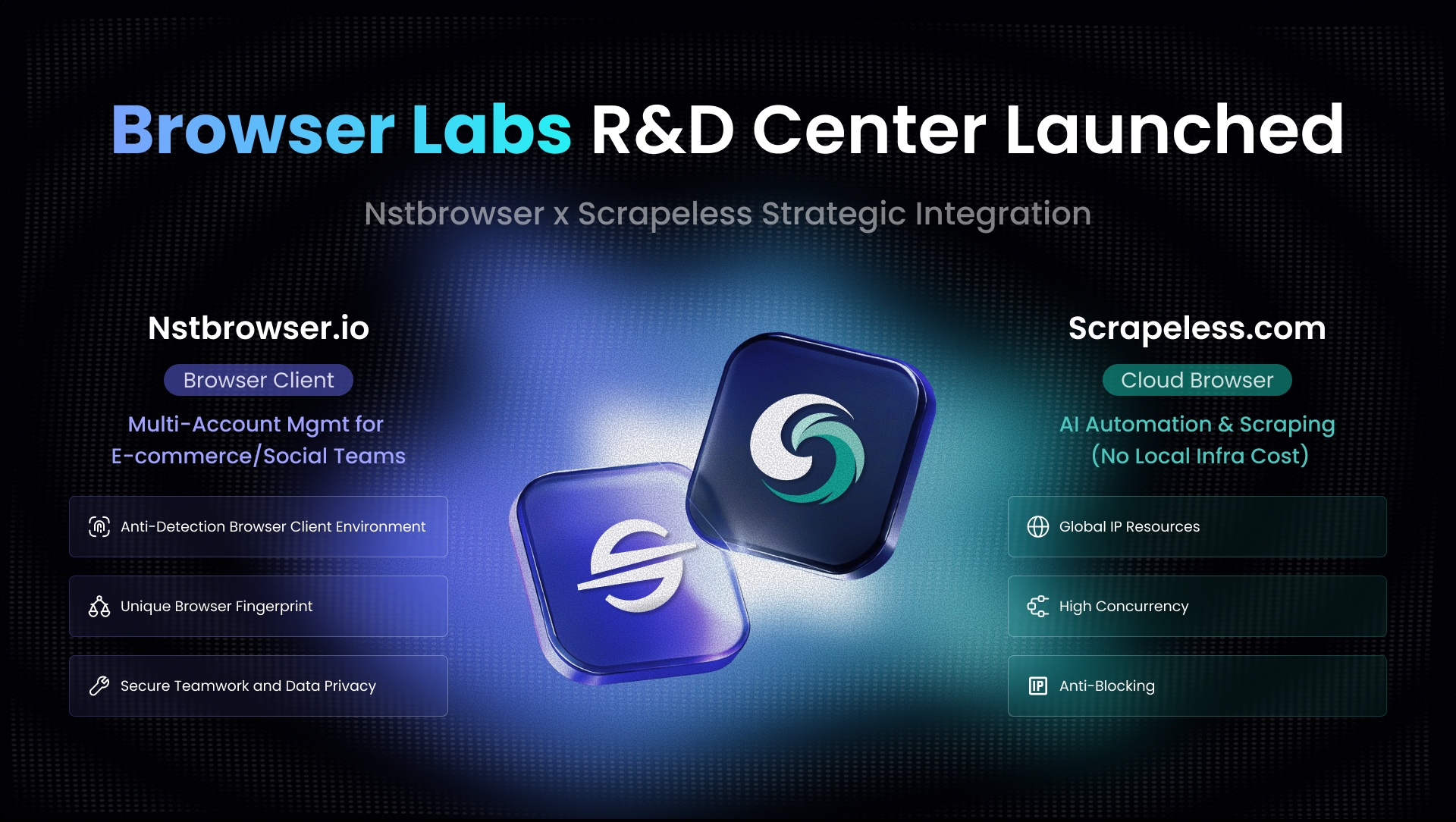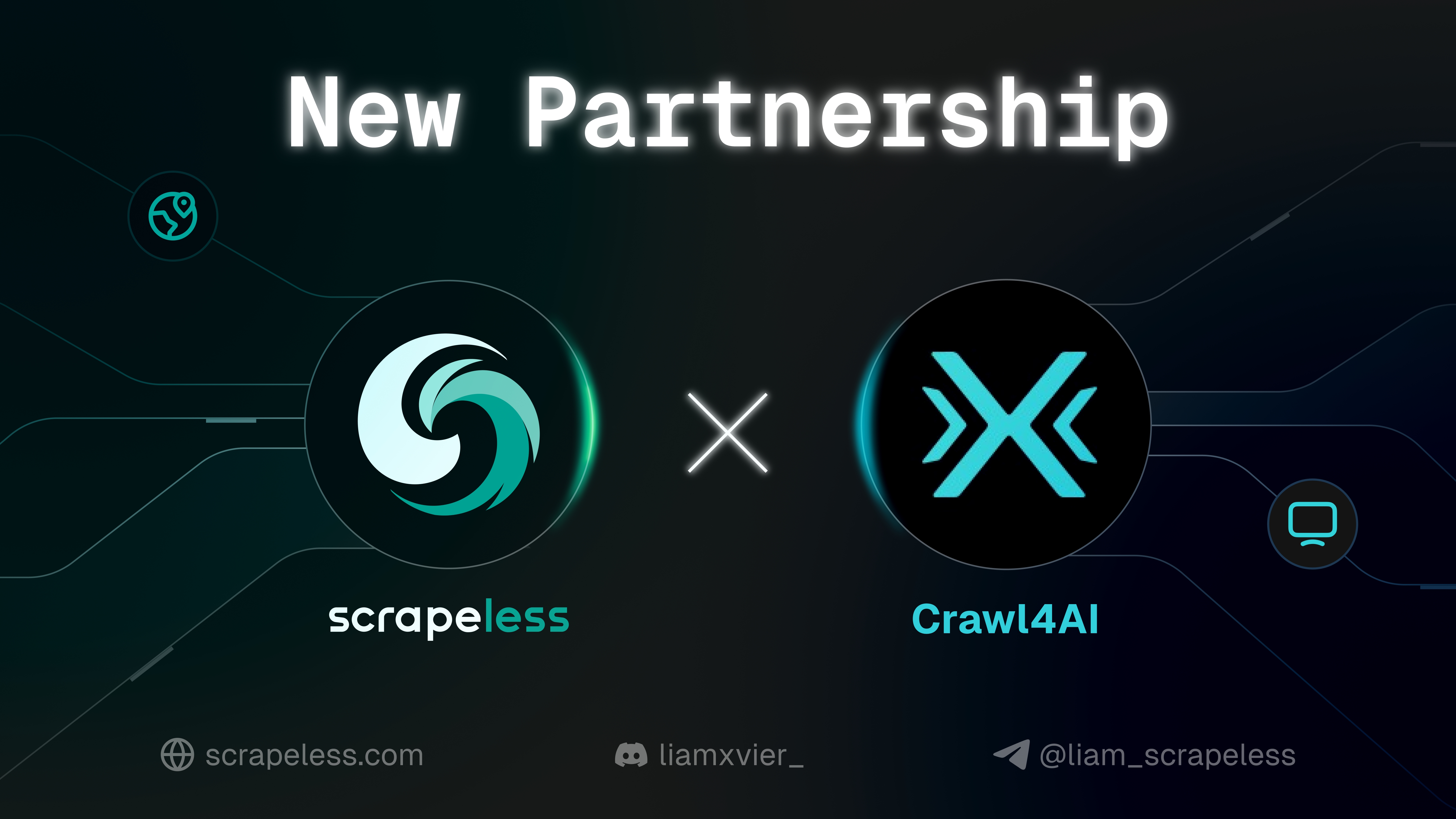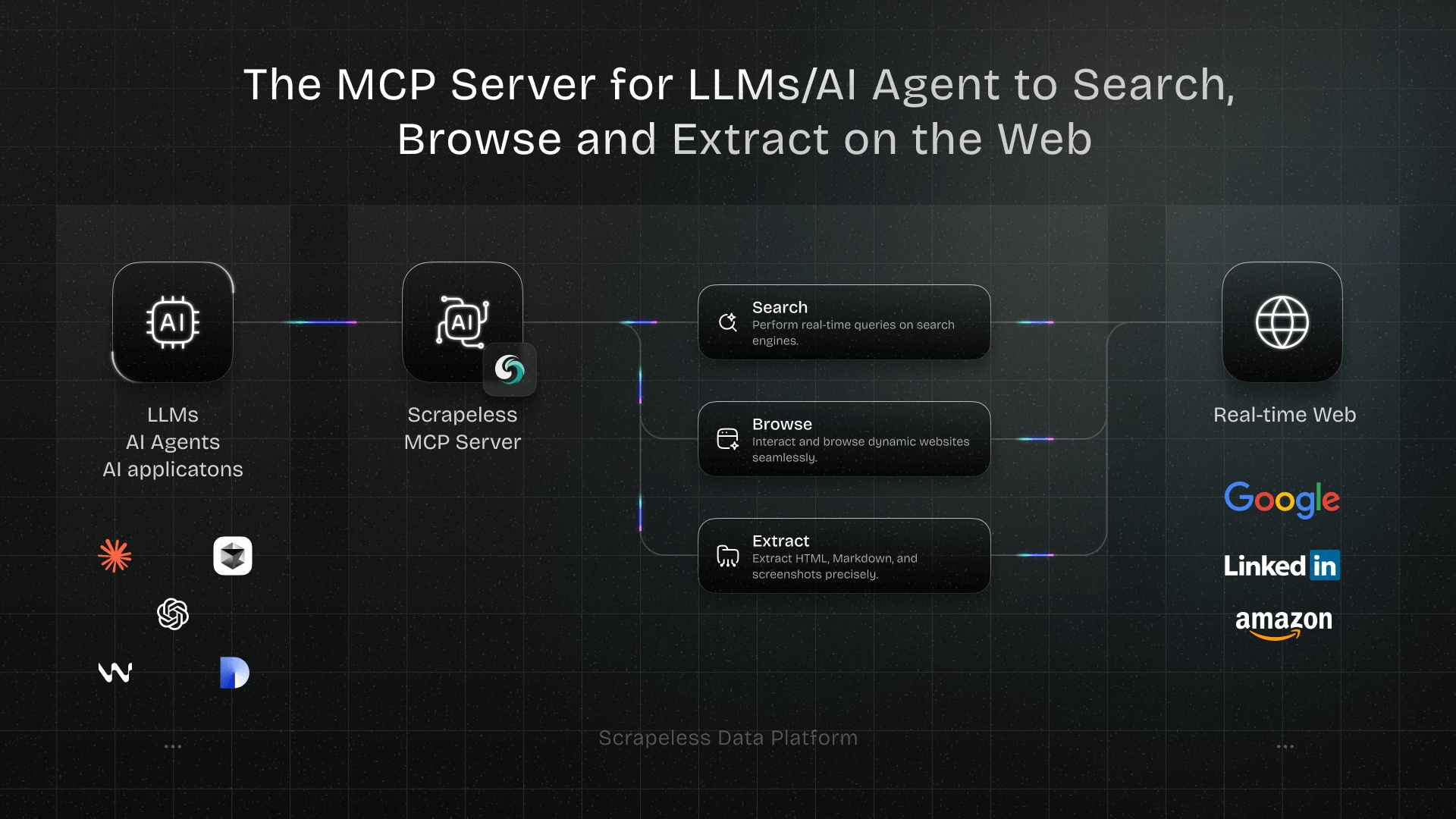What is AI Scraping? Benefits & Use Cases
Expert Network Defense Engineer
Key Takeaways
- AI scraping leverages artificial intelligence to automate and enhance data extraction from websites, offering significant advantages over traditional methods.
- It uses machine learning, natural language processing, and pattern recognition to adapt to website changes and extract both structured and unstructured data.
- Key benefits include improved accuracy, resilience against anti-bot measures, automation at scale, and contextual insights.
- AI scraping is crucial for various applications, including market research, price monitoring, sentiment analysis, and AI model training data generation.
- Scrapeless provides a powerful, managed API solution that simplifies AI-enhanced web scraping, handling complexities like anti-bot bypass and JavaScript rendering.
Introduction
In today's data-driven world, extracting valuable information from the web is more critical than ever. Traditional web scraping methods, while effective for static content, often struggle with dynamic websites, evolving layouts, and sophisticated anti-bot measures. This is where AI scraping emerges as a game-changer. AI scraping integrates artificial intelligence algorithms into the data extraction process, offering unparalleled adaptability, efficiency, and depth of insight. This article will explore what AI scraping is, how it works, and its significant benefits and diverse use cases across various industries. We will also highlight how a robust, managed solution like Scrapeless can empower your AI scraping initiatives, transforming raw web data into actionable intelligence with ease.
What is AI Scraping?
AI scraping refers to the advanced process of extracting data from websites using artificial intelligence algorithms. Unlike conventional web scraping, which relies on predefined rules and static selectors, AI scraping employs machine learning (ML), natural language processing (NLP), and pattern recognition to intelligently interpret and extract information. This allows the scraper to adapt to changes in website structure, handle dynamic content, and even understand the context and sentiment of the data being collected [1].
At its core, AI scraping moves beyond simply following instructions; it learns. It can identify relevant data points based on their meaning and relationships rather than just their location on a page. This makes it significantly more robust and resilient to the constant evolution of web design and anti-scraping technologies.
How Does AI Scraping Work?
AI-powered web scraping combines the foundational mechanics of traditional scraping with intelligent AI layers. The process typically involves three main stages:
1. Data Acquisition with Enhanced Resilience
This initial stage involves sending requests to target websites and receiving their content. However, with AI scraping, this process is enhanced by AI-driven techniques to overcome common obstacles. AI models can mimic human browsing behavior, intelligently rotate proxies, and solve CAPTCHAs to ensure successful access to the website. This layer focuses on reliably collecting both structured data (like product listings, tables) and unstructured data (like reviews, articles) [2].
2. Intelligent Data Interpretation and Extraction
Once the raw web content is acquired, AI algorithms come into play to interpret and extract the desired data. Instead of rigid XPath or CSS selectors, AI models use NLP and pattern recognition to understand the content's meaning. For example, an AI scraper can identify a product price even if its HTML tag changes, because it understands what a price looks like and means in context. This stage also involves cleaning and normalizing the data, transforming it into a usable format by removing irrelevant information and standardizing values.
3. Adaptability and Continuous Learning
One of the most significant differentiators of AI scraping is its ability to adapt. Through continuous learning and feedback loops, AI scrapers can recognize changes in website layouts or data presentation. If a website updates its design, a traditional scraper might break, requiring manual re-configuration. An AI scraper, however, can often self-adjust by re-learning the new patterns, ensuring long-term data extraction reliability with minimal human intervention. This adaptability makes AI scraping ideal for projects requiring sustained data collection from frequently updated sources.
AI Scraping vs. Traditional Web Scraping: A Comparison
While both methods aim to extract web data, their approaches and capabilities differ significantly:
| Feature / Aspect | Traditional Web Scraping | AI Scraping |
|---|---|---|
| Methodology | Rule-based (fixed selectors, scripts) | AI-driven (ML, NLP, pattern recognition) |
| Adaptability | Fragile; breaks with website changes | Flexible; adapts to website changes |
| Data Types Handled | Primarily structured data | Structured and unstructured data |
| Anti-Bot Resilience | Low; easily blocked | High; mimics human behavior, intelligent bypass |
| Maintenance | Frequent manual updates required | Minimal manual intervention; self-adjusting |
| Complexity Handling | Limited to static rules | Interprets context, meaning, sentiment |
| Resource Intensity | Lower (HTTP requests) | Higher (AI model processing) |
| Output Quality | Dependent on selector accuracy | Improved accuracy, contextual insights |
Key Benefits of AI Scraping
AI scraping offers a multitude of benefits that address the limitations of traditional methods, making it a powerful tool for modern data acquisition:
1. Enhanced Accuracy and Data Quality
AI algorithms can interpret data in context, reducing errors and inconsistencies often found in rule-based scraping. They can identify and extract relevant information more precisely, even from complex or semi-structured content. This leads to higher quality datasets that are more reliable for analysis and decision-making.
2. Superior Resilience Against Anti-Bot Measures
Websites are constantly deploying advanced anti-bot technologies. AI scrapers can mimic human browsing patterns, handle dynamic content loading, and intelligently manage proxies and CAPTCHAs, significantly increasing their success rate in bypassing these defenses. This ensures consistent data flow where traditional scrapers would fail [3].
3. Automation at Scale with Minimal Maintenance
The self-learning and adaptive nature of AI scrapers means they require less manual intervention. Once trained, they can continue to operate effectively even if website layouts change, drastically reducing maintenance overhead. This allows for large-scale, continuous data collection with greater efficiency and fewer resources.
4. Extraction of Unstructured and Contextual Data
Traditional scrapers are best suited for structured data. AI scraping, particularly with NLP capabilities, can extract meaningful insights from unstructured text, such as customer reviews, social media posts, or news articles. It can perform sentiment analysis, identify key entities, and understand relationships within the text, providing richer, more contextual data.
5. Faster Decision-Making and Competitive Advantage
By providing more accurate, comprehensive, and timely data, AI scraping empowers businesses to make faster and more informed decisions. Whether it's real-time price monitoring, trend analysis, or competitive intelligence, the insights gained from AI-scraped data can provide a significant competitive edge in rapidly evolving markets.
Common Use Cases for AI Scraping
AI scraping is highly versatile and finds applications across a wide range of industries and functions:
1. Market Research and Competitive Intelligence
Businesses use AI scraping to gather extensive market data, including competitor pricing, product features, customer reviews, and promotional strategies. AI can analyze this data to identify market trends, pricing gaps, and competitive advantages, enabling companies to refine their strategies and stay ahead [4].
2. Price Monitoring and Dynamic Pricing
E-commerce businesses leverage AI scraping to continuously monitor product prices across various online retailers. AI can detect price changes in real-time, analyze pricing strategies, and even suggest dynamic pricing adjustments to maximize revenue and competitiveness. This is crucial for maintaining optimal pricing in a fast-paced online marketplace.
3. Sentiment Analysis and Brand Monitoring
AI scraping with NLP capabilities is invaluable for collecting and analyzing public sentiment from social media, forums, news articles, and review sites. Companies can monitor brand perception, identify emerging issues, and understand customer satisfaction levels at scale, allowing for proactive reputation management and improved customer engagement.
4. Lead Generation and Sales Intelligence
Sales and marketing teams use AI scraping to extract contact information, company details, and industry insights from business directories, professional networks, and job boards. AI can help qualify leads by identifying key decision-makers and understanding their needs, thereby streamlining the sales pipeline and improving conversion rates.
5. AI Model Training Data Generation
One of the most direct applications of AI scraping is generating high-quality training data for other AI and machine learning models. This includes collecting vast datasets of text, images, and structured records that are essential for training large language models (LLMs), computer vision systems, and predictive analytics models. AI scraping ensures the data is clean, relevant, and diverse [5].
6. Financial Data Collection and Analysis
Financial institutions and analysts use AI scraping to gather real-time financial news, stock prices, company filings, and economic indicators from various sources. AI can then process this data to identify investment opportunities, assess market risks, and feed into algorithmic trading strategies.
7. Content Aggregation and News Monitoring
Media companies and researchers utilize AI scraping to aggregate articles, blog posts, and news from hundreds or thousands of sources. AI can categorize content, identify trending topics, and summarize information, providing comprehensive and up-to-date insights for editorial decisions or research purposes.
8. Academic Research and Data Science
Academics and data scientists employ AI scraping to collect large datasets for research across disciplines, from social sciences to bioinformatics. AI helps in extracting specific data points from scientific publications, public databases, and online repositories, facilitating large-scale analysis and discovery.
9. Real Estate Market Analysis
AI scraping can collect property listings, pricing trends, neighborhood data, and demographic information from real estate websites. This data can be analyzed by AI to predict market values, identify investment opportunities, and provide insights for real estate developers and investors.
10. Cybersecurity and Threat Intelligence
In cybersecurity, AI scraping is used to monitor the dark web, forums, and news sources for mentions of vulnerabilities, exploits, or threats. AI can identify patterns and anomalies in this data, helping organizations to proactively detect and respond to potential cyber threats.
Why Scrapeless is Your Essential Partner for AI-Enhanced Web Scraping
While AI scraping offers incredible power and flexibility, implementing it effectively still presents challenges. Building and maintaining sophisticated AI models for web data extraction requires significant technical expertise, computational resources, and constant adaptation to the ever-changing web landscape. This is where Scrapeless steps in as an indispensable partner, simplifying the complexities of AI-enhanced web scraping.
Scrapeless is a comprehensive, managed web scraping API designed to handle the most challenging aspects of web access and data extraction. By integrating Scrapeless into your AI scraping workflow, you can:
- Focus on AI Logic, Not Infrastructure: Scrapeless abstracts away the complexities of proxy management, anti-bot bypass, and JavaScript rendering. This allows your AI models and data scientists to focus purely on developing and refining the intelligent extraction and interpretation logic, rather than battling with web access issues.
- Guaranteed Data Delivery: Leveraging a vast network of rotating proxies and advanced anti-bot technologies, Scrapeless ensures your requests consistently reach target websites, even those with the strongest defenses. This means your AI models always have a reliable stream of data to work with.
- Full JavaScript Rendering for Rich Data: Many modern websites rely heavily on JavaScript. Scrapeless fully renders these pages, providing your AI with the complete, loaded HTML content, ensuring no data is missed due to dynamic loading.
- Scalability and Efficiency: Scrapeless's managed infrastructure scales automatically to meet your demands, eliminating the need for you to manage servers or maintain complex scraping setups. This makes large-scale AI scraping projects feasible and cost-effective.
- Simplified Integration: With a straightforward API, Scrapeless can be easily integrated into any Python or other programming language environment, complementing your existing AI and data processing pipelines.
By partnering with Scrapeless, you empower your AI scraping initiatives with a robust, reliable, and scalable foundation. It allows you to harness the full potential of AI for data extraction, turning web data into a strategic asset without the operational headaches.
Conclusion and Call to Action
AI scraping represents a significant leap forward in web data extraction, transforming a traditionally rule-based process into an intelligent, adaptive, and highly efficient one. Its ability to handle dynamic content, bypass sophisticated anti-bot measures, and extract contextual insights from both structured and unstructured data makes it an indispensable tool for businesses and researchers in 2025. From market intelligence and price monitoring to sentiment analysis and AI model training, the benefits and use cases of AI scraping are vast and continue to expand.
However, unlocking the full potential of AI scraping often requires overcoming complex infrastructure challenges. This is where a powerful, managed solution like Scrapeless becomes your essential ally. By abstracting away the complexities of web access, proxy management, and anti-bot bypass, Scrapeless allows you to focus on developing and deploying your AI-driven data extraction strategies with confidence and unparalleled reliability.
Ready to revolutionize your data acquisition with AI-enhanced web scraping?
Discover how Scrapeless can elevate your projects and start your free trial today!
FAQ (Frequently Asked Questions)
Q1: What is the main difference between AI scraping and traditional web scraping?
A1: The main difference lies in adaptability and intelligence. Traditional scraping relies on fixed rules and breaks easily with website changes. AI scraping uses machine learning and NLP to adapt to changes, interpret content contextually, and handle dynamic data, making it more robust and less maintenance-intensive.
Q2: Can AI scraping bypass all anti-bot detection systems?
A2: While no system can guarantee 100% bypass indefinitely, AI scraping significantly improves resilience against anti-bot measures. It mimics human behavior, intelligently rotates proxies, and can solve CAPTCHAs, offering a much higher success rate than traditional methods. Managed solutions like Scrapeless further enhance this capability.
Q3: Is AI scraping suitable for extracting unstructured data?
A3: Yes, AI scraping is particularly well-suited for unstructured data. With its natural language processing (NLP) capabilities, AI can extract meaning, sentiment, and entities from text-heavy content like reviews, social media posts, and articles, which is a major limitation for traditional rule-based scrapers.
Q4: What are the primary benefits of using AI scraping for businesses?
A4: Businesses benefit from AI scraping through enhanced accuracy, superior resilience against anti-bot measures, automation at scale with less maintenance, and the ability to extract contextual insights from unstructured data. These lead to faster decision-making, competitive advantage, and higher quality data for various strategic applications.
Q5: How does Scrapeless integrate with AI scraping efforts?
A5: Scrapeless acts as a managed API service that handles the complex web access layer for AI scraping. It provides guaranteed access to websites by managing proxies, bypassing anti-bot systems, and rendering JavaScript. This allows developers and AI models to focus on the intelligent data extraction and interpretation logic, while Scrapeless ensures reliable data delivery.
References
[1] Oxylabs: What is AI Scraping? Benefits & Use Cases: Oxylabs AI Scraping Guide
[2] Medium: The Ultimate Guide to AI-Powered Web Scraping: Medium AI Scraping Guide
[3] Bright Data: AI Web Scraping: Bright Data AI Scraping
[4] PromptCloud: Top 7 Web Scraping Use Cases in AI and Machine Learning: PromptCloud AI/ML Use Cases
[5] Datablist: AI Scraping Explained: From What to Why and How: Datablist AI Scraping Explained
At Scrapeless, we only access publicly available data while strictly complying with applicable laws, regulations, and website privacy policies. The content in this blog is for demonstration purposes only and does not involve any illegal or infringing activities. We make no guarantees and disclaim all liability for the use of information from this blog or third-party links. Before engaging in any scraping activities, consult your legal advisor and review the target website's terms of service or obtain the necessary permissions.



